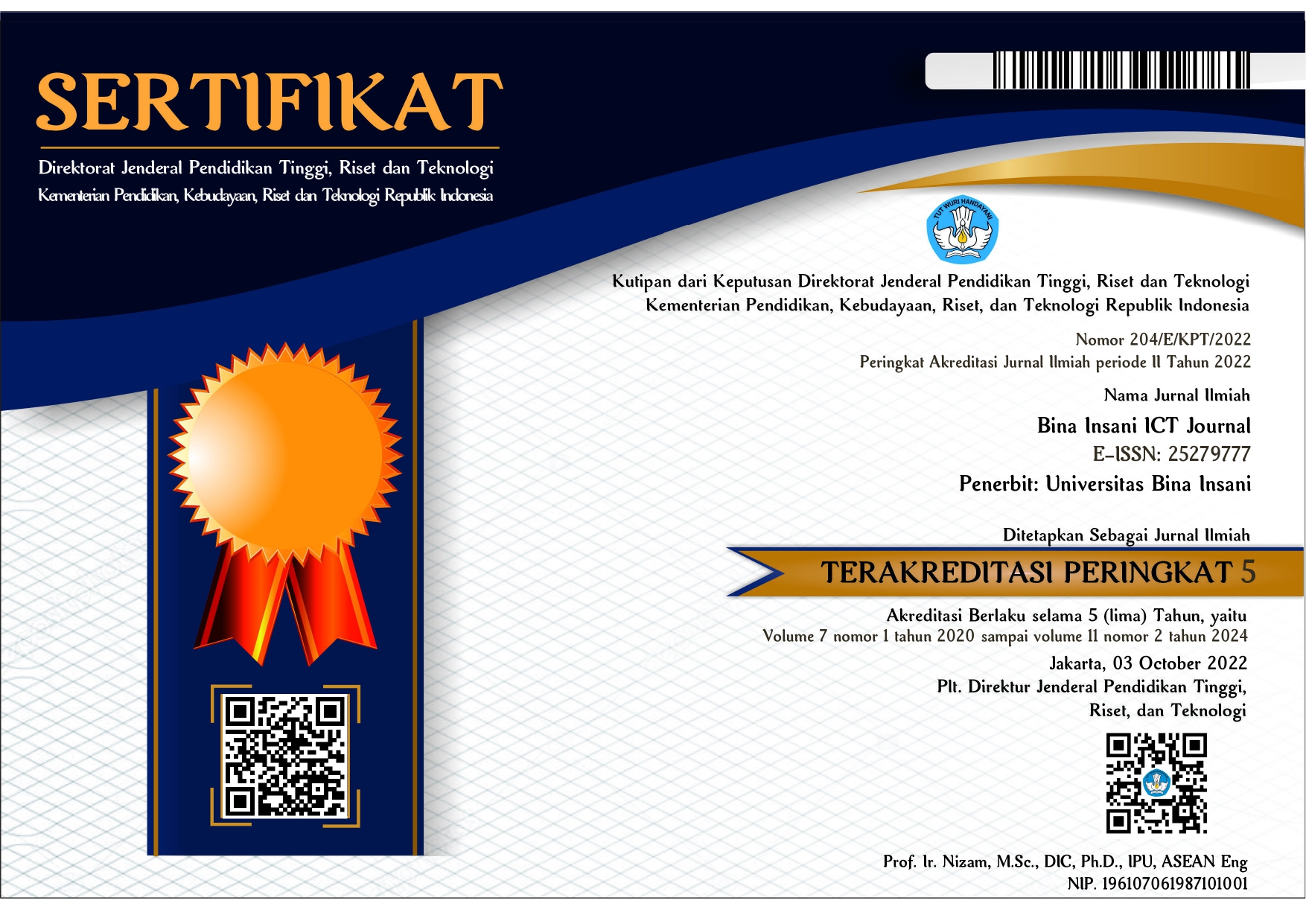Audit Kualitas Software ERP Axapta Menggunakan Standard ISO 9126
Abstract
Abstrak: Model kualitas perencanaan sumber daya perusahaan (ERPAXAPTA) sistem ini digunakan dengan mengadaptasi standar ISO9126. Model ini digunakan untuk memverifikasi bahwa apakah implementasi ERP AXAPTA sistem akan berhasil atau gagal di perusahaan. Tujuh karakteristik kualitas disarankan untukmenjadi persyaratan minimum untuk menciptakan model kualitas sistem ERP, termasuk fungsi, keandalan, kegunaan, efisiensi, pemeliharaan, portabilitas dan black box testing sistem ERP. Kualitas karakteristik tidak dapat diukur secara langsung. Jadi dalam penelitian ini, mereka dibagi menjadi dua puluh tujuh subcharacteristicsKata kunci: knowledge, perangkat lunak kualitas model, kualitas karakteristik dan ERPAXAPTA model kualitas, ISO 9126Abstract: The quality model of enterprise resource planning (ERP) systems by adapting the ISO9126 standard. This model is used to verify that whether the implementation of ERP systems will succeed or fail in higher educational institutions. Seven quality characteristics are suggested to be minimum requirements for creating the quality model of ERP systems, including functionality, reliability, usability, efficiency, maintainability, portability and black box testing of ERP systems. The quality characteristics could not be measured directly. Thus in this study, they are divided into twenty seven subcharacteristics.Keywords: knowledge, software quality models, quality characteristics and Axapta ERP model of quality, ISO 9126References
Pressman R.S. 2010. Software Engineering : a practitioner’s approach, McGraw-Hill, New York, 68.
Marimin. 2004. Teknik dan Aplikasi Pengambilan Keputusan Kriteria Majemuk. Jakarta: Grasindo.
Rainer R, Turban E, Potter RE. 2006. Introduction to Information Systems: Supporting and Transforming Business, USA: John Wiley.
Ellen Monk,Bret Wagner. 2013. Concept In Enterprise Resource Planning. Course Technology. USA: Boston.
Qutaishat, F.T, Khattab, S.A, Abu Zaid, M.K.S, Al-Manasra,E.A. 2012. The Effect of ERP Successful Implementation on Employees' Productivity, Service Quality and Innovation: An Empirical Study in Telecommunication Sector in Jordan. Int.J.Bus.Manage. 7(19), 45-54.
Uppatumwichian,W. 2009. Moving ERP Research Forward: the Future Directions for ERP Research. In: Proceedings of the 3rd Eurepean Conference on Information Management and Evaluation, Gothenburg, Sweden.
Muhmmad I Nofal, Zawiyah M Yusof. 2013. Integration of Business Intelligence and Enterprise Resource Planning within Organizations. The 4th International Conference on Electrical Engineering and Informatics (ICEEI 2013). (Volume 11,2013, Pages 658-665).
(Mike Ehrenberg, April 2011) Microsoft Dynamics AX. 2012. A New Generation in ERP,Seattle ,USA
Lewis. 1995. IBM Computer Usability Satisfaction Questionnaires:Psychometric Evaluation and Instruction for Use. International Journal of Human-Computer Interaction,7:1, 57-78
Waworuntu A, Evawaty T. 2013. Document Manajement System Menggunakan Open-Source CMS, Drupal. Jurnal Teknologi Informatika, Vol.5 No.2 Juli 2013, Hal. 19-31.
Vidushi S, Prachi B. 2011. Maintainability Analysis Of Component Based Systems, International Journal of Software Engineering and Its Applications, Vol. 5 No.3, July, 2011.
Thamer A. A, Muhairat M, Althunibat A. 20103. Evaluating the Quality of Software in ERP Systems Using the ISO 9126 Model, International Journal of Ambient Systems and Applications (IJASA) Vol. 1, No.1, March 2013.
Fransisca L, Ledis C. 2003. Quality Characteristics for Software Architecture, Journal of Object Technology, 2003, Vol.2, No.2, March-April 2003.
Marimin. 2004. Teknik dan Aplikasi Pengambilan Keputusan Kriteria Majemuk. Jakarta: Grasindo.
Rainer R, Turban E, Potter RE. 2006. Introduction to Information Systems: Supporting and Transforming Business, USA: John Wiley.
Ellen Monk,Bret Wagner. 2013. Concept In Enterprise Resource Planning. Course Technology. USA: Boston.
Qutaishat, F.T, Khattab, S.A, Abu Zaid, M.K.S, Al-Manasra,E.A. 2012. The Effect of ERP Successful Implementation on Employees' Productivity, Service Quality and Innovation: An Empirical Study in Telecommunication Sector in Jordan. Int.J.Bus.Manage. 7(19), 45-54.
Uppatumwichian,W. 2009. Moving ERP Research Forward: the Future Directions for ERP Research. In: Proceedings of the 3rd Eurepean Conference on Information Management and Evaluation, Gothenburg, Sweden.
Muhmmad I Nofal, Zawiyah M Yusof. 2013. Integration of Business Intelligence and Enterprise Resource Planning within Organizations. The 4th International Conference on Electrical Engineering and Informatics (ICEEI 2013). (Volume 11,2013, Pages 658-665).
(Mike Ehrenberg, April 2011) Microsoft Dynamics AX. 2012. A New Generation in ERP,Seattle ,USA
Lewis. 1995. IBM Computer Usability Satisfaction Questionnaires:Psychometric Evaluation and Instruction for Use. International Journal of Human-Computer Interaction,7:1, 57-78
Waworuntu A, Evawaty T. 2013. Document Manajement System Menggunakan Open-Source CMS, Drupal. Jurnal Teknologi Informatika, Vol.5 No.2 Juli 2013, Hal. 19-31.
Vidushi S, Prachi B. 2011. Maintainability Analysis Of Component Based Systems, International Journal of Software Engineering and Its Applications, Vol. 5 No.3, July, 2011.
Thamer A. A, Muhairat M, Althunibat A. 20103. Evaluating the Quality of Software in ERP Systems Using the ISO 9126 Model, International Journal of Ambient Systems and Applications (IJASA) Vol. 1, No.1, March 2013.
Fransisca L, Ledis C. 2003. Quality Characteristics for Software Architecture, Journal of Object Technology, 2003, Vol.2, No.2, March-April 2003.
Published
2016-06-01
How to Cite
WICAKSONO, Harjunadi.
Audit Kualitas Software ERP Axapta Menggunakan Standard ISO 9126.
BINA INSANI ICT JOURNAL, [S.l.], v. 3, n. 1, p. 107 - 121, june 2016.
ISSN 2527-9777.
Available at: <http://ejournal-binainsani.ac.id/index.php/BIICT/article/view/808>. Date accessed: 08 sep. 2024.
Section
Articles

This work is licensed under a Creative Commons Attribution-NonCommercial-ShareAlike 4.0 International License.
















